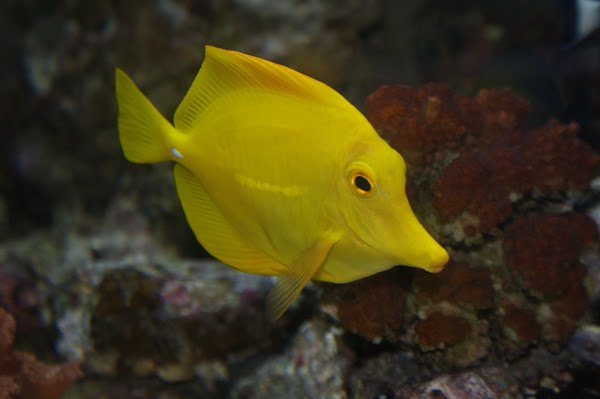
You might be wondering, “How do yellow tangs find their way?” or “What do they say to each other beneath the waves?” In this article, we’ll explore these questions and more. We’ll break down how yellow tangs navigate their surroundings, the unique ways they communicate, and why understanding these behaviors matters, not just for fish enthusiasts but also for anyone curious about the wonders of the ocean.
Understanding the Yellow Tang’s Habitat
Let’s start by looking at where yellow tangs call home. These vibrant fish are native to the warm waters of the Pacific Ocean, particularly around the Hawaiian Islands. You could think of their habitat as a bustling underwater city full of coral reefs and rocks. These structures provide shelter from predators and places to find food.
Yellow tangs often swim among the corals, darting in and out of crevices. This not only helps them stay safe but also allows them to forage for algae, which is a big part of their diet. Because they’re herbivores, they have a special relationship with their environment, helping to keep algae growth in check. So, in a sense, they’re like the gardeners of the reef!
Navigating Through Visual Cues
Now, let’s talk about how yellow tangs journey through their world. These fish rely heavily on visual cues to navigate. With their keen eyesight, they can spot changes in their environment, such as light patterns filtering through water or the shapes of coral formations.
Think of it like driving a car; you keep your eyes on the road and watch for signs. Yellow tangs do the same as they swim, using their vision to assess their surroundings. They may also recognize familiar landmarks, like specific coral structures, to help guide them. This ability is crucial, especially when they need to find food or avoid danger.
The Role of Color and Patterns in Communication
What’s truly intriguing about yellow tangs is how they use their vibrant color and body movements as forms of communication. We often think of fish as silent creatures, but they have their own language! For instance, during mating season, male yellow tangs may display brighter colors and more pronounced swimming patterns to attract females.
This communication isn’t just about attracting mates; it’s also about establishing territory. If a yellow tang feels its space is being invaded, it might change its color slightly or engage in more aggressive swimming to assert dominance. Think of it like a neighborhood watch—these bright colors signal to others, “Hey, this is my turf!”
Sound and Pressure Communication
Believe it or not, yellow tangs can communicate through sound as well. While they don’t “talk” like we do, they produce low-frequency sounds that can travel through water. This is particularly useful in murky environments where visibility is limited. In situations where they need to warn other tangs about predators, these sounds can act like an alarm system.
Additionally, fish can sense pressure changes in the water. This means when a yellow tang is near another, they might pick up on each other’s movements and adjust their behavior accordingly. It’s a bit like how we can feel someone’s presence even without seeing them right away.
The Importance of Social Interaction
Yellow tangs are social creatures. They typically form small groups, which helps them navigate and communicate more effectively. Being in a group can provide safety in numbers, as they can watch out for each other when lurking predators are nearby.
In these groups, tangs can engage in playful behaviors, like chasing each other or swimming in synchronized patterns. This social interaction not only strengthens their bonds but also aids in navigation and gathering food. Picture a small team working together—each fish plays a critical role, and their shared experience enhances survival chances.
Challenges in Navigation and Communication
Unfortunately, yellow tangs face several challenges that can impact their navigation and communication. Habitat destruction, overfishing, and pollution pose significant threats. When coral reefs are damaged, the fish lose their homes and the visual cues that help them navigate. This can lead to disorientation and difficulty finding food.
Moreover, noise pollution from boats and human activities can disrupt their communication. If they can’t hear the warning sounds of peers, they might be more vulnerable to threats. This highlights just how interconnected their navigation and communication are with the health of their environment.
Conservation and the Future of Yellow Tangs
Understanding how yellow tangs navigate and communicate is crucial for their conservation. Protecting their habitats ensures that these vibrant fish can continue their vital roles in marine ecosystems. You might be wondering what you can do to help.
Engaging in local conservation efforts, reducing plastic use, and advocating for sustainable fishing practices can make a difference. By taking small steps, you contribute to the health of ocean habitats, allowing future generations of yellow tangs to thrive. It’s a team effort, just like the schools of tangs working together to survive and navigate their underwater world.
In conclusion, yellow tangs are more than just pretty fish. Their navigation skills and complex communication methods reveal a lot about their lives beneath the waves. By understanding these behaviors, we can appreciate the delicate balance of ocean ecosystems and take steps to protect these captivating creatures. So, the next time you see a yellow tang swimming by, remember these insights and consider the extraordinary world they inhabit.
